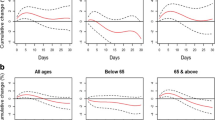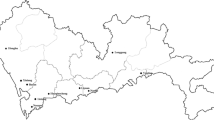Abstract
To assess differences in the lag-effect pattern in the relationship between particulate matter less than 10 μm in aerodynamic diameter (PM10) and cause-specific mortality in Seoul, Korea, from January 1995 to December 1999, we performed a time-series analysis. We used a generalized additive Poisson regression model to control for time trends, temperature, humidity, air pressure, and the day of the week. The PM10 effect was estimated on the basis of the time-series models using the 24-h means and the quadratic distributed-lag models using a cumulative 6-day effect. One interquartile range increase in the 6-day cumulative mean of PM10 (43.12 µg/m3) was associated with an increase in non-accidental deaths [3.7%, 95% confidence interval (CI): 2.1, 5.4], respiratory disease (13.9%, 95% CI: 6.8, 21.5), cardiovascular disease (4.4%, 95% CI: –1.0, 9.0), and cerebrovascular disease (6.3%, 95% CI: 2.3, 10.5). We found the following patterns in the disease-specific lag-effect window: respiratory mortality was more affected by air pollution level on the day of death, whereas cardiovascular deaths were more affected by the previous day's air pollution level. Cerebrovascular deaths were simultaneously associated with the air pollution levels of the same day and the previous day. The patterns in the lag effect from the distributed-lag models were similar to those of a series of time-series models with 24-h means. These results contribute to our understanding of how exposure to air pollution causes adverse health effects.

Similar content being viewed by others
References
Akaike H (1973) Information theory and an extension of the maximum likelihood principle. In: Petrov BN, Caski F (eds) Second International Symposium on Information Theory, Budapest, 1973. Akademiai Kiado, Budapest, pp 267–281
Braga A, Zanobetti A, Schwartz J (2001) Structure between particulate air pollution and respiratory and cardiovascular deaths in 10 US cities. J Occup Environ Med 43:927–933
Bremner SA, Anderson HR, Atkinson RW, McMichael AJ, Strachan DP, Bland JM, et al (1999) Short term associations between outdoor air pollution and mortality in London 1992–4. Occup Environ Med 56:237–244
Daniels MJ, Dominici F, Samet JM, Zeger SL (2000) Estimating particulate matter – mortality dose-response curves and threshold levels. An analysis of daily time-series for the 20 largest US cities. Am J Epidemiol 152:397–406
Goldberg MS, Burnett RT, Bailar JC III, Brook J, Bonvalot Y, Tamblyn R, et al (2001a) The association between daily mortality and ambient air particle pollution in Montreal, Quebec. 1. Nonaccidental mortality. Environ Res [A] 86:12–25
Goldberg MS, Burnett RT, Bailar JC III, Brook J, Bonvalot Y, Tamblyn R, et al (2001b) The association between daily mortality and ambient air particle pollution in Montreal, Quebec. 2. Cause-specific mortality. Environ Res [A] 86:26–36
Ha EH, Hong YC, Lee BE, Woo BH, Schwartz J, Christiani DC (2001) Is air pollution a risk factor for low birth weight in Seoul? Epidemiology 12:643–648
Hastie T, Tibshirani R (1990) Generalized additive models. Chapman and Hall, London
Hong YC, Leem JH, Ha EH, Christiani CD (1999) PM10 exposure, gaseous pollutants, and daily mortality in Incheon, south Korea. Environ Health Perspect 107:873–878
Hong YC, Lee JT, Kim H, Ha EH, Schwartz J, Christiani CD (2002) Effects of air pollutants on acute stroke mortality. Environ Health Perspect 110:187–191
Lee JT, Shin D, Chung Y (1999) Air pollution and daily mortality in Seoul and Ulsan, Korea. Environ Health Perspct 107:149–154
Lee JT, Kim H, Hong YC, Kwon HJ, Schwartz J, Christiani DC (2000) Air pollution and daily mortality in seven major cities of Korea, 1991–1997. Environ Res [A] 84:247–254
Katsouyanni K, Touloumi G, Spix C, et al (1997) Short-term effects of ambient sulphur dioxide and particulate matter on mortality in 12 European cities: results from the APHEA projects. Br Med J 314:1658–1663
Kwon HJ, Cho SH, Nyberg F, Pershagen G (2001) Effects of ambient air pollution on daily mortality in a cohort of patients with congestive heart failure. Epidemiology 12:413–419
Ostro BD, Hurley S, Lipsett MJ (1999) Air pollution and daily mortality in the Coachella Valley, California. A study of PM10 dominated by coarse particles. Environ Res [A] 81:231–238
Peters A, Liu E, Verrier RL, Schwartz J, Gold DR, Mittleman M, et al (2000) Air pollution and incidence of cardiac arrhythmia. Epidemiology 11:11–17
Pope CA III, Schwartz J (1996) Time series for the analysis of pulmonary health data. Am J Respir Crit Care Med 154:S229–S233
Rossi G, Vigott, MA, Zanobetti A, Repetto F, Gianelle V, Schwartz J (1999) Air pollution and cause-specific mortality in Milan, Italy, 1980–1989. Arch Environ Health 54:158–164
Schwartz J (2000) The distributed lag between air pollution and daily deaths. Epidemiology 11:320–326
Schwartz J, Dockery DW (1992) Increased mortality in Philadelphia associated with daily air pollution concentrations. Am Rev Respir Dis 145:600–604
Acknowledgements.
This study was supported by a grant for reform of university education under the BK project of S.N.U. and was also partly supported by the Ministry of Health and Welfare, Republic of Korea (HMP-99-M-09 0007). The authors declare that the whole process of this study complies with the current law of the Republic of Korea.
Author information
Authors and Affiliations
Corresponding author
Rights and permissions
About this article
Cite this article
Kim, H., Kim, Y. & Hong, YC. The lag-effect pattern in the relationship of particulate air pollution to daily mortality in Seoul, Korea. Int J Biometeorol 48, 25–30 (2003). https://doi.org/10.1007/s00484-003-0176-0
Received:
Accepted:
Published:
Issue Date:
DOI: https://doi.org/10.1007/s00484-003-0176-0




